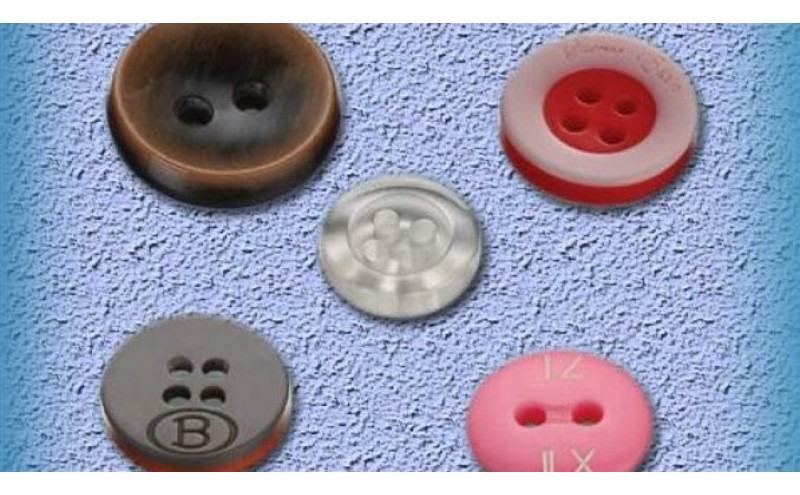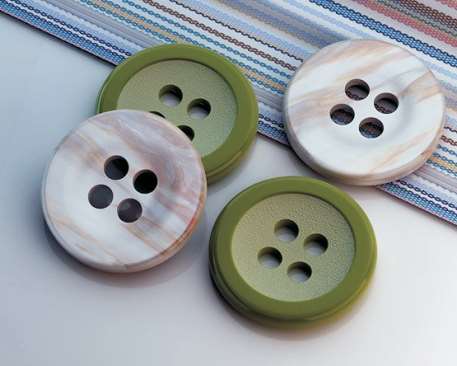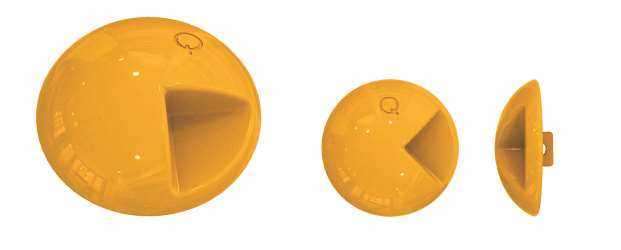Differences Between Perforated Sew-on Button and Footed Button - Blazer Jacket Button

Buttons are often considered just a small fastening tool, and we often underestimate that. In fact, there are several different types of buttons, each with their own characteristics, attributes, and purposes.
Two of the most common types of buttons are flat buttons and shank buttons, which are commonly used on various types of clothing. In this article, we will discuss the main differences between the two types and a few points to consider before purchasing.
1. Structure / Shape
Flat buttons can also be divided into two-hole and four-hole flat button types. However, the main feature between the two is that there are plains with holes in the middle. The holes are used to sew the thread to fasten the button to the garment.

On the other hand, on the back of the buttons with shank a perforated handle, which will be used to sew the thread to attach the button. Due to this body structure, knobs with handles can come in many different shapes, and this is often considered the main advantage.

2.Production Process
Due to the difference in shape, both types go through different manufacturing processes and can be produced with different materials according to the need.
Flat buttons typically go through a relatively simple manufacturing process: the material, usually plastic, is molded into the desired shape and two or four holes are added.
However, with shank switches, the process can be much more complicated due to the shaft itself, which is the hollow protruding piece. The protrusion may be a separate part fused to the button unit. In other cases, the stem may be molded directly from the button material, a common situation with buttons made of special materials such as glass or shell. Due to the more complex manufacturing process, buttons with loop are generally more expensive than flat buttons. Zamak shank buttons, when cast, are monolithic with the sewing shank button. Due to the property of the material, it does not rust, and with a smooth coating, buttons resistant to external factors are obtained. The production goal of our company is to produce durable and long-lasting products for our customers.
3.Application
Flat buttons are inexpensive and can be sewn with a sewing machine. They are often more versatile. However, flat buttons are generally not suitable for heavier garments and mixing and matching colors and shapes can be very difficult. Plain buttons are often the more common choice for formal wear because of their simplicity.
Because of their stiffer construction, shank buttons are better suited with heavier garments such as leather jackets or blazers. Plus, with a wide selection of sizes, shapes, and colors, it's easier to mix and match knobs with handles to a variety of projects.
Button Buying Tips
- First, determine your needs, especially what type of clothing you will be using. In general, shank buttons are a better choice for heavier garments.
- Note that you cannot machine sew a pommel button, so you will need to consider the extra effort and time required.

-Kalkan-Desenli-E-965-SET6-2-350x350.jpg)
-Kalkan-Desenli-E-966-SET8-2-350x350.jpg)
11 Comment(s)
澳门金沙游戏登入 | https://184244.com/滿天星探索線上棋牌遊戲的新趨勢與未來發展/3/index.html
澳门金沙免费开户 | https://184244.com/滿天星探索線上棋牌遊戲的新趨勢與未來發展/4/index.html
澳门金沙免费代理 | https://184244.com/滿天星探索線上棋牌遊戲的新趨勢與未來發展/5/index.html
澳门金沙试玩账号 | https://184244.com/滿天星探索線上棋牌遊戲的新趨勢與未來發展/index.html
澳门金沙真人网站 | https://184244.com/滿天星解析如何在骰寶遊戲挑戰中尋找娛樂與成功/2/index.html
澳门金沙真人在线游戏 | https://184244.com/滿天星解析如何在骰寶遊戲挑戰中尋找娛樂與成功/3/index.html
澳门金沙真人在线 | https://184244.com/滿天星解析如何在骰寶遊戲挑戰中尋找娛樂與成功/4/index.html
澳门金沙真人官网 | https://184244.com/滿天星解析如何在骰寶遊戲挑戰中尋找娛樂與成功/5/index.html
澳门金沙真人开户 | https://184244.com/滿天星解析如何在骰寶遊戲挑戰中尋找娛樂與成功/index.html
澳门金沙真人代理 | https://184244.com/線上賓果遊戲:互動與樂趣的新境界/2/index.html
澳门金沙真人百家乐 | https://184244.com/線上賓果遊戲:互動與樂趣的新境界/3/index.html
澳门金沙真人百家乐开户 | https://184244.com/線上賓果遊戲:互動與樂趣的新境界/4/index.html
澳门金沙真人百家乐代理 | https://184244.com/線上賓果遊戲:互動與樂趣的新境界/5/index.html
澳门金沙真人百家乐游戏 | https://184244.com/線上賓果遊戲:互動與樂趣的新境界/index.html
澳门金沙真人百家乐官网 | https://184244.com/致富娛樂城-優惠活動/2/index.html
澳门金沙娱乐城官方网站 | https://184244.com/致富娛樂城-優惠活動/3/index.html
澳门金沙百家乐 | https://184244.com/致富娛樂城-優惠活動/4/index.html
澳门金沙百家乐开户 | https://184244.com/致富娛樂城-優惠活動/5/index.html
澳门金沙百家乐代理 | https://184244.com/致富娛樂城-優惠活動/index.html
澳门金沙百家乐官网 | https://184244.com/花語與運勢:太陽城揭開花朵背後的神秘訊/2/index.html
澳门金沙百家乐游戏 | https://184244.com/花語與運勢:太陽城揭開花朵背後的神秘訊/3/index.html
澳门金沙百家乐在线 | https://184244.com/花語與運勢:太陽城揭開花朵背後的神秘訊/4/index.html
澳门金沙百家乐在线开户 | https://184244.com/花語與運勢:太陽城揭開花朵背後的神秘訊/5/index.html
澳门金沙百家乐在线代理 | https://184244.com/花語與運勢:太陽城揭開花朵背後的神秘訊/index.html
金沙 | https://184244.com/賭局中的危機:深探輪盤風險/2/index.html
金沙真人官方 | https://184244.com/賭局中的危機:深探輪盤風險/3/index.html
金沙游戏规则 | https://184244.com/賭局中的危機:深探輪盤風險/4/index.html
金沙技巧 | https://184244.com/賭局中的危機:深探輪盤風險/5/index.html
金沙补牌规则 | https://184244.com/賭局中的危機:深探輪盤風險/index.html
金沙技巧打法 | https://184244.com/跟著太陽城進入區塊鏈革命:遊戲業的數位/2/index.html
金沙公式打法 | https://184244.com/跟著太陽城進入區塊鏈革命:遊戲業的數位/3/index.html
金沙开户 | https://184244.com/跟著太陽城進入區塊鏈革命:遊戲業的數位/4/index.html
金沙代理 | https://184244.com/跟著太陽城進入區塊鏈革命:遊戲業的數位/5/index.html
金沙在线 | https://184244.com/跟著太陽城進入區塊鏈革命:遊戲業的數位/index.html
金沙在线娱乐 | https://184244.com/追尋老虎機投注的奧秘:探索賭場魔法背後的科學/2/index.html
金沙官方网 | https://184244.com/追尋老虎機投注的奧秘:探索賭場魔法背後的科學/3/index.html
金沙AG | https://184244.com/追尋老虎機投注的奧秘:探索賭場魔法背後的科學/4/index.html
金沙真人免费玩 | https://184244.com/追尋老虎機投注的奧秘:探索賭場魔法背後的科學/5/index.html
金沙真人免费开户 | https://184244.com/追尋老虎機投注的奧秘:探索賭場魔法背後的科學/index.html
金沙网址 | https://184244.com/隨著太陽城探索美式輪盤:深入探討美式輪/2/index.html
金沙娱乐城 | https://184244.com/隨著太陽城探索美式輪盤:深入探討美式輪/3/index.html
金沙娱乐开户 | https://184244.com/隨著太陽城探索美式輪盤:深入探討美式輪/4/index.html
金沙娱乐代理 | https://184244.com/隨著太陽城探索美式輪盤:深入探討美式輪/5/index.html
金沙娱乐官网 | https://184244.com/隨著太陽城探索美式輪盤:深入探討美式輪/index.html
金沙官网 | https://184244.com/雷神之鎚奇蹟:探索線上娛樂城老虎機最強之選/2/index.html
金沙在线代理 | https://184244.com/雷神之鎚奇蹟:探索線上娛樂城老虎機最強之選/3/index.html
金沙在线开户 | https://184244.com/雷神之鎚奇蹟:探索線上娛樂城老虎機最強之選/4/index.html
金沙官方网址 | https://184244.com/雷神之鎚奇蹟:探索線上娛樂城老虎機最強之選/5/index.html
金沙官方开户 | https://184244.com/雷神之鎚奇蹟:探索線上娛樂城老虎機最強之選/index.html
金沙官方代理 | https://184344.com/21點規則-太陽城/index.html
金沙官方赌场 | https://184344.com/cookie政策-太陽城/index.html
金沙官方娱乐 | https://184344.com/使用條款/index.html
金沙娱乐 | https://184344.com/免責聲明-太陽城/index.html
金沙娱乐场app | https://184344.com/免費送體驗金-太陽城/index.html
金沙博彩官网 | https://184344.com/吃角子老虎機-太陽城/index.html
金沙娱乐场 | https://184344.com/娛樂城儲值-太陽城/index.html
金沙老虎机怎么玩 | https://184344.com/娛樂城出金-太陽城/index.html
金沙app | https://184344.com/娛樂城推薦-太陽城/index.html
金沙筹码 | https://184344.com/娛樂城推薦-太陽城/index1.html
金沙棋牌 | https://184344.com/娛樂城註冊-太陽城/index.html
金沙澳门 | https://184344.com/娛樂城評價-太陽城/index.html
金沙国际 | https://184344.com/娛樂城首儲-太陽城/index.html
金沙人 | https://184344.com/彩票-太陽城/index.html
金沙 会员 | https://184344.com/捕魚機-太陽城/index.html
金沙赌场会员卡 | https://184344.com/新註冊體驗金娛樂城-太陽城/index.html
金沙会员卡 | https://184344.com/新註冊體驗金娛樂城-太陽城/index1.html
金沙 香港 | https://184344.com/棋牌-太陽城/index.html
金沙 威尼斯 | https://184344.com/百家樂-太陽城/index.html
金沙 金沙 | https://184344.com/百家樂-太陽城.html
金沙 官网 | https://184344.com/百家樂介紹-太陽城/index.html
金沙logo | https://184344.com/百家樂介紹-太陽城/index1.html
金沙落成 | https://184344.com/百家樂攻略-太陽城/index.html
金沙老虎機 | https://184344.com/百家樂玩法-太陽城/index.html
澳門 金沙 | https://184344.com/百家樂玩法-太陽城.html
金沙 poker | https://184344.com/百家樂破解-太陽城/index.html
金沙平台 | https://184344.com/真人遊戲-太陽城/index.html
金沙体彩投注中心 | https://184344.com/真人遊戲-太陽城.html
金沙集团 | https://184344.com/老虎機-太陽城/index.html
金沙网站 | https://184344.com/老虎機介紹-太陽城/index.html
金沙网上赌场 | https://184344.com/老虎機玩法-太陽城/index.html
金沙娛樂 | https://184344.com/聯絡我們-太陽城/index.html
金沙怎么玩 | https://184344.com/運彩投注-太陽城/index.html
金沙娱乐场 澳门 | https://184344.com/運彩投注站-太陽城/index.html
金沙娱乐城 澳门 | https://184344.com/運彩線上投注-太陽城/index.html
金沙娱乐场 巴士 | https://184344.com/運彩線上投注教學-太陽城/index.html
金沙赌场 会员 | https://184344.com/關於我們-太陽城/index.html
金沙赌场 英语 | https://184344.com/隱私權政策-太陽城/index.html
澳门金沙app | https://184344.com/電子遊戲-太陽城/index.html
金沙下载 | https://184344.com/體育博彩-太陽城/index.html
澳门金沙集团 | https://184344.com/體驗金-太陽城/index.html
澳门金沙集团APP | https://184344.com/體驗金-太陽城.html
澳门金沙娱乐 | https://184544.com/bng電子技巧/index.html
澳门金沙赌场 | https://184544.com/bng電子老虎機玩法/index.html
澳门金沙官网 | https://184544.com/tag/bng老虎機/index.html
澳门金沙网址 | https://184544.com/tag/bng電子/index.html
澳门金沙博彩 | https://184544.com/tag/bng電子技巧/index.html
澳门金沙网络赌博平台 | https://184544.com/tag/bng電子老虎機玩法/index.html
澳门金沙娱乐城 | https://184544.com/tag/dg百家樂/index.html
澳门金沙APP | https://184544.com/tag/qk娛樂城/index.html
澳门金沙集团官网 | https://184544.com/tag/rsg雷神/index.html
澳门金沙娱乐开户 | https://184544.com/tag/rsg雷神之錘/index.html
澳门金沙娱乐代理 | https://184544.com/tag/娛樂城/index.html
澳门金沙网络博彩 | https://184544.com/tag/娛樂城優惠/index.html
澳门金沙在线开户 | https://184544.com/tag/娛樂城推薦/index.html
澳门金沙在线代理 | https://184544.com/tag/娛樂城體驗金/index.html
澳门金沙在线官网 | https://184544.com/tag/娛樂城體驗金投注/index.html
澳门金沙赌博 | https://184544.com/tag/娛樂城體驗金投注策略/index.html
澳门金沙在线赌博 | https://184544.com/tag/歐博真人/index.html
澳门金沙赌博开户 | https://184544.com/tag/線上娛樂城/index.html
澳门金沙赌博代理 | https://184544.com/tag/線上老虎機/index.html
澳门金沙博彩公司 | https://184544.com/娛樂城體驗金投注策略/index.html
澳门金沙网址大全 | https://2212580.com/2024年最新最熱門線上娛樂城竟然是它-挑選娛樂城適/index.html
澳门金沙如何开户 | https://2212580.com/2024年線上兩大最新娛樂城大比拼:太陽城-vs-888casino/index.html
澳门金沙在线网址 | https://2212580.com/pubg電子競技之巔:探索刺激的絕地求生槍擊世界/index.html
澳门金沙娱乐网址 | https://2212580.com/《守望先鋒》超高電競熱潮:太陽城未來將/index.html
澳门金沙博彩网址 | https://2212580.com/《守望先鋒》超高電競熱潮:太陽城未來將-2/index.html
澳门金沙博彩开户 | https://2212580.com/享受鬥地主的樂趣:太陽城的極致棋牌體驗/index.html
澳门金沙如何代理 | https://2212580.com/什麼是電競投注!來太陽城了解全攻略與超/index.html
澳门金沙哪里开户 | https://2212580.com/太陽城-優惠活動/index.html
澳门金沙官方网址 | https://2212580.com/太陽城-最新文章/index.html
金沙集团APP | https://2212580.com/太陽城-賭場遊戲與玩家體驗全解析大公開/index.html
金沙洗钱案 | https://2212580.com/太陽城中的賓果:經典遊戲的無窮樂趣/index.html
金沙周焯华 | https://2212580.com/太陽城全新隆重登場-★各位會員敬請注意★/index.html
金沙博彩 | https://2212580.com/太陽城德州撲克:策略與技巧-掌握牌桌上的/index.html
金沙网络赌博平台 | https://2212580.com/太陽城捕魚機大揭秘:新手玩法、技巧、注/index.html
金沙APP | https://2212580.com/太陽城揭開百家樂一場智慧與運氣的賭博遊/index.html
金沙集团官网 | https://2212580.com/太陽城與你一起追逐勝利-常規賽馬的魅力/index.html
金沙网络博彩 | https://2212580.com/娛樂城大對決!搖錢樹-vs-pokerstars:哪個娛樂城更勝一籌/index.html
金沙在线官网 | https://2212580.com/想挑戰21點的刺激與樂趣,就來太陽城體驗!/index.html
金沙赌博 | https://2212580.com/想要體驗的美式輪盤的精采刺激就來太陽城/index.html
金沙在线赌博 | https://2212580.com/挑戰智慧極限:5大德州撲克技巧,揭開娛樂城撲克/index.html
金沙赌博开户 | https://2212580.com/挑戰運氣,追逐勝利-揭開棒球博彩的精彩世界/index.html
金沙赌博代理 | https://2212580.com/探索rsg電子老虎機《開心農場》:盡享太陽城-2/index.html
金沙博彩公司 | https://2212580.com/探索rsg電子老虎機《開心農場》:盡太陽城/index.html
金沙网址大全 | https://2212580.com/探索幸運之樹:把搖錢樹的發財之運帶到線上娛樂/index.html
金沙如何开户 | https://2212580.com/揭秘太陽城:優惠大放送,讓你嗨翻賺翻天/index.html
金沙在线网址 | https://2212580.com/最新最奢華的太陽城:打造您的尊貴娛樂時/index.html
金沙娱乐网址 | https://2212580.com/線上德州撲克的魅力:太陽城帶你暢玩撲克/index.html
金沙博彩网址 | https://2212580.com/誕生與歷史:回顧ps1的經典/index.html
金沙博彩开户 | https://2212580.com/進入新時代:2024奧運迎來電競的挑戰與機會/index.html
金沙如何代理 | https://2212580.com/運動彩票:探索娛樂與投資的多重面向與未來發展/index.html
金沙哪里开户 | https://464744.com/7-個全有或全無賭博策略.html
金沙app下载 | https://464744.com/7-個跡象表明你賭博太多.html
线上金沙 | https://464744.com/7-種最差的初學者賭場遊戲.html
线上金沙开户 | https://464744.com/9個幫助您獲得幸運的賭博技巧.html
线上金沙代理 | https://464744.com/ava娛樂城.html
线上金沙官网 | https://464744.com/ava娛樂城優惠活動.html
线上金沙娱乐 | https://464744.com/【捕魚機】多玩多賺-你必須清楚的4大重點攻略.html
金沙集团老板 | https://464744.com/【捕魚須知】捕魚機三週期及八大技巧.html
金沙集团酒店 | https://464744.com/【百家樂必勝錦囊心法】玩家必看.html
金沙博弈 | https://464744.com/二十一點.html
金沙迪士尼 | https://464744.com/二十一點1.html
金沙 斗六 | https://464744.com/二十一點密技.html
金沙股票 | https://464744.com/二十一點心法.html
金沙集团股东 | https://464744.com/二十一點技巧.html
金沙集团ptt | https://464744.com/二十一點技術.html
金沙集团主席 | https://464744.com/二十一點教學.html
金沙品牌 | https://464744.com/二十一點的真正秘密揭曉.html
金沙 ptt | https://464744.com/二十一點破解.html
金沙推荐 | https://464744.com/二十一點秘密.html
金沙体育 | https://464744.com/二十一點秘笈.html
金沙娱乐城ptt | https://464744.com/二十一點竅門.html
金沙娱乐集团 | https://464744.com/二十一點莊家似乎總是獲勝的-7-個原因.html
金沙集团 赌场 | https://464744.com/二十一點解析.html
金沙集团app | https://464744.com/二十一點解說.html
金沙集团网址 | https://464744.com/二十一點課程.html
金沙电子 | https://464744.com/二十一點講解.html
金沙电子游戏 | https://464744.com/什麼定義了鬆散的老虎機:rtp-還是波動性?.html
金沙电子游戏试玩 | https://464744.com/什麼是娛樂城ava娛樂城告訴你.html
金沙电子游戏官网 | https://464744.com/你不應該玩輪盤賭的-3-個理由和你應該玩的-3-個理由.html
金沙在线电子游戏 | https://464744.com/你應該嘗試成為一名專業的老虎機玩家嗎?.html
金沙棋牌游戏 | https://464744.com/你應該總是在老虎機上賭最大嗎?.html
金沙视讯 | https://464744.com/你為什麼賭博?答案很有價值.html
金沙彩票游戏 | https://464744.com/你相信的二十一點的6個荒謬謊言.html
金沙捕鱼 | https://464744.com/你能以玩老虎機為生嗎?.html
金沙捕鱼游戏 | https://464744.com/你能用大數字策略打敗輪盤賭嗎?.html
金沙电子竞技 | https://464744.com/像專業人士一樣玩百家樂的-4-種方法.html
金沙体育开户 | https://464744.com/優惠活動.html
金沙体育下注 | https://464744.com/優惠活動1.html
金沙体育官方 | https://464744.com/克服老虎機殭屍綜合症的-3-種策略.html
金沙体育赛事 | https://464744.com/出款免手續費.html
沙巴体育 | https://464744.com/出款免手續費每週兩次.html
BTL体育 | https://464744.com/出金娛樂城.html
皇冠体育 | https://464744.com/初學者的4個頂級老虎機技巧.html
新皇冠体育 | https://464744.com/即使您很少或沒有錢也如何賭博.html
SBO体育 | https://464744.com/台灣娛樂城.html
三昇体育 | https://464744.com/台灣線上娛樂城.html
AG真人 | https://464744.com/吃角子老虎機一般玩法介紹.html
BG真人 | https://464744.com/各家娛樂城介紹.html
pp真人 | https://464744.com/呼朋引伴,舊帶新送500.html
bbin真人 | https://464744.com/在二十一點中拆分和加倍下注的最佳和最差時間.html
OG真人 | https://464744.com/在二十一點中花更少的錢加倍.html
OG视讯 | https://464744.com/在撲克中贏更多錢的-10-種簡單方法.html
AB真人 | https://464744.com/在線-7-款最佳冒險主題老虎機.html
MT棋牌 | https://464744.com/大多數玩家不知道的-5-條老虎機規則和策略.html
WG棋牌 | https://464744.com/大數字輪盤策略(有效嗎?).html
瓦力棋牌 | https://464744.com/天天續儲,天天送10.html
FG棋牌 | https://464744.com/如何判斷老虎機是否誠實.html
KX棋牌 | https://464744.com/如何在拉斯維加斯的輪盤賭中獲勝的-6-個技巧.html
KY棋牌 | https://464744.com/如何玩百家樂.html
乐游棋牌 | https://464744.com/如何總是贏二十一點.html
VG棋牌 | https://464744.com/如何通過線上博弈謀生.html
AG捕鱼 | https://464744.com/娛樂城-賭場賭博的-4-個級別.html
JDB捕鱼 | https://464744.com/娛樂城.html
FG捕鱼 | https://464744.com/娛樂城1.html
MW捕鱼 | https://464744.com/娛樂城不出金.html
CQ9捕鱼 | https://464744.com/娛樂城介紹.html
VG捕鱼 | https://464744.com/娛樂城優惠.html
MT捕鱼 | https://464744.com/娛樂城優惠活動.html
KY捕鱼 | https://464744.com/娛樂城出金.html
乐游捕鱼 | https://464744.com/娛樂城分析.html
瓦力捕鱼 | https://464744.com/娛樂城合法.html
DS捕鱼 | https://464744.com/娛樂城合法嗎.html
BBIN捕鱼 | https://464744.com/娛樂城和加密貨幣之間的-7-個最大相似之處.html
BB捕鱼 | https://464744.com/娛樂城大全.html
CQ9电子 | https://464744.com/娛樂城差異.html
PP电子 | https://464744.com/娛樂城常見問題.html
BBIN电子 | https://464744.com/娛樂城常見問題1.html
JDB电子 | https://464744.com/娛樂城平台.html
YP电子 | https://464744.com/娛樂城技巧.html
PT电子 | https://464744.com/娛樂城指南.html
AG电子 | https://464744.com/娛樂城指南1.html
HB电子 | https://464744.com/娛樂城排名.html
MW电子 | https://464744.com/娛樂城推薦.html
XIN电子 | https://464744.com/娛樂城推薦168娛樂城會出金嗎.html
SW电子 | https://464744.com/娛樂城推薦17娛樂城會出金嗎.html
GO电子 | https://464744.com/娛樂城推薦181娛樂城會出金嗎.html
KA电子 | https://464744.com/娛樂城推薦3a娛樂城會出金嗎.html
SG电子 | https://464744.com/娛樂城推薦5818娛樂城會出金嗎.html
LGD电子 | https://464744.com/娛樂城推薦589娛樂城會出金嗎.html
MT电子 | https://464744.com/娛樂城推薦666娛樂城會出金嗎.html
天天彩票 | https://464744.com/娛樂城推薦88win娛樂城會出金嗎.html
双赢彩票 | https://464744.com/娛樂城推薦911娛樂城會出金嗎.html
VR彩票 | https://464744.com/娛樂城推薦a9娛樂城會出金嗎.html
雷火电竞 | https://464744.com/娛樂城推薦aka娛樂城會出金嗎.html
六合彩 | https://464744.com/娛樂城推薦au8娛樂城會出金嗎.html
六合彩开奖 | https://464744.com/娛樂城推薦bok娛樂城會出金嗎.html
澳门六合彩 | https://464744.com/娛樂城推薦cash88娛樂城會出金嗎.html
香港六合彩 | https://464744.com/娛樂城推薦ddya娛樂城會出金嗎.html
澳门六合彩开奖 | https://464744.com/娛樂城推薦feida365娛樂城會出金嗎.html
香港六合彩开奖 | https://464744.com/娛樂城推薦gtr娛樂城會出金嗎.html
澳门六合彩投注 | https://464744.com/娛樂城推薦hoya娛樂城會出金嗎.html
香港六合彩投注 | https://464744.com/娛樂城推薦i88娛樂城會出金嗎.html
沙巴体育投注 | https://464744.com/娛樂城推薦iwin娛樂城會出金嗎.html
BTL体育投注 | https://464744.com/娛樂城推薦js娛樂城會出金嗎.html
皇冠体育投注 | https://464744.com/娛樂城推薦jy娛樂城會出金嗎.html
新皇冠体育投注 | https://464744.com/娛樂城推薦kanx娛樂城會出金嗎.html
SBO体育投注 | https://464744.com/娛樂城推薦ku娛樂城會出金嗎.html
三昇体育投注 | https://464744.com/娛樂城推薦leo娛樂城會出金嗎.html
AG真人投注 | https://464744.com/娛樂城推薦luck娛樂城會出金嗎.html
BG真人投注 | https://464744.com/娛樂城推薦m70娛樂城會出金嗎.html
pp真人投注 | https://464744.com/娛樂城推薦play娛樂城會出金嗎.html
bbin真人投注 | https://464744.com/娛樂城推薦q8娛樂城會出金嗎.html
OG真人投注 | https://464744.com/娛樂城推薦rm娛樂城會出金嗎.html
OG视讯投注 | https://464744.com/娛樂城推薦rone娛樂城會出金嗎.html
AB真人投注 | https://464744.com/娛樂城推薦s8娛樂城會出金嗎.html
MT棋牌投注 | https://464744.com/娛樂城推薦swag娛樂城會出金嗎.html
WG棋牌投注 | https://464744.com/娛樂城推薦t99娛樂城會出金嗎.html
瓦力棋牌投注 | https://464744.com/娛樂城推薦tha娛樂城會出金嗎.html
FG棋牌投注 | https://464744.com/娛樂城推薦tu娛樂城會出金嗎.html
KX棋牌投注 | https://464744.com/娛樂城推薦tz娛樂城會出金嗎.html
KY棋牌投注 | https://464744.com/娛樂城推薦w娛樂城會出金嗎.html
乐游棋牌投注 | https://464744.com/娛樂城推薦yg娛樂城會出金嗎.html
VG棋牌投注 | https://464744.com/娛樂城推薦九州娛樂城會出金嗎.html
AG捕鱼投注 | https://464744.com/娛樂城推薦互博國際娛樂城會出金嗎.html
JDB捕鱼投注 | https://464744.com/娛樂城推薦京城國際娛樂城會出金嗎.html
FG捕鱼投注 | https://464744.com/娛樂城推薦仟匯娛樂城會出金嗎.html
MW捕鱼投注 | https://464744.com/娛樂城推薦任你博娛樂城會出金嗎.html
CQ9捕鱼投注 | https://464744.com/娛樂城推薦億興娛樂城會出金嗎.html
VG捕鱼投注 | https://464744.com/娛樂城推薦八方娛樂城會出金嗎.html
MT捕鱼投注 | https://464744.com/娛樂城推薦公奕娛樂城會出金嗎.html
KY捕鱼投注 | https://464744.com/娛樂城推薦冠天下娛樂城會出金嗎.html
乐游捕鱼投注 | https://464744.com/娛樂城推薦凡賽斯娛樂城會出金嗎.html
瓦力捕鱼投注 | https://464744.com/娛樂城推薦勝利娛樂城會出金嗎.html
DS捕鱼投注 | https://464744.com/娛樂城推薦博京娛樂城會出金嗎.html
BBIN捕鱼投注 | https://464744.com/娛樂城推薦博贏娛樂城會出金嗎.html
BB捕鱼投注 | https://464744.com/娛樂城推薦博鑫娛樂城會出金嗎.html
CQ9电子投注 | https://464744.com/娛樂城推薦博馬娛樂城會出金嗎.html
PP电子投注 | https://464744.com/娛樂城推薦合悅娛樂城會出金嗎.html
BBIN电子投注 | https://464744.com/娛樂城推薦名人廳娛樂城會出金嗎.html
JDB电子投注 | https://464744.com/娛樂城推薦大巨人娛樂城會出金嗎.html
YP电子投注 | https://464744.com/娛樂城推薦大巨蛋娛樂城會出金嗎.html
PT电子投注 | https://464744.com/娛樂城推薦大眾娛樂城會出金嗎.html
AG电子投注 | https://464744.com/娛樂城推薦大總裁娛樂城會出金嗎.html
HB电子投注 | https://464744.com/娛樂城推薦大老爺娛樂城會出金嗎.html
MW电子投注 | https://464744.com/娛樂城推薦太陽城娛樂城會出金嗎.html
XIN电子投注 | https://464744.com/娛樂城推薦好贏娛樂城會出金嗎.html
SW电子投注 | https://464744.com/娛樂城推薦威博娛樂城會出金嗎.html
GO电子投注 | https://464744.com/娛樂城推薦客萊柏娛樂城會出金嗎.html
KA电子投注 | https://464744.com/娛樂城推薦富美娛樂城會出金嗎.html
SG电子投注 | https://464744.com/娛樂城推薦富豪娛樂城會出金嗎.html
LGD电子投注 | https://464744.com/娛樂城推薦寶島娛樂城會出金嗎.html
MT电子投注 | https://464744.com/娛樂城推薦就發娛樂城會出金嗎.html
天天彩票投注 | https://464744.com/娛樂城推薦帝禾娛樂城會出金嗎.html
双赢彩票投注 | https://464744.com/娛樂城推薦彩金娛樂城會出金嗎.html
VR彩票投注 | https://464744.com/娛樂城推薦招財兔娛樂城會出金嗎.html
雷火电竞投注 | https://464744.com/娛樂城推薦摩斯國際娛樂城會出金嗎.html
六合彩投注 | https://464744.com/娛樂城推薦新世界娛樂城會出金嗎.html
沙巴体育玩法 | https://464744.com/娛樂城推薦新天下娛樂城會出金嗎.html
BTL体育玩法 | https://464744.com/娛樂城推薦星亞娛樂城會出金嗎.html
皇冠体育玩法 | https://464744.com/娛樂城推薦星匯娛樂城會出金嗎.html
新皇冠体育玩法 | https://464744.com/娛樂城推薦星富娛樂城會出金嗎.html
SBO体育玩法 | https://464744.com/娛樂城推薦星皇娛樂城會出金嗎.html
三昇体育玩法 | https://464744.com/娛樂城推薦東吉娛樂城會出金嗎.html
AG真人玩法 | https://464744.com/娛樂城推薦東聖神洲娛樂城會出金嗎.html
BG真人玩法 | https://464744.com/娛樂城推薦樂虎娛樂城會出金嗎.html
pp真人玩法 | https://464744.com/娛樂城推薦歐博娛樂城會出金嗎.html
bbin真人玩法 | https://464744.com/娛樂城推薦永旺娛樂城會出金嗎.html
OG真人玩法 | https://464744.com/娛樂城推薦永豐娛樂城會出金嗎.html
OG视讯玩法 | https://464744.com/娛樂城推薦泊樂娛樂城會出金嗎.html
AB真人玩法 | https://464744.com/娛樂城推薦法拉利娛樂城會出金嗎.html
MT棋牌玩法 | https://464744.com/娛樂城推薦泰京娛樂城會出金嗎.html
WG棋牌玩法 | https://464744.com/娛樂城推薦派大金娛樂城會出金嗎.html
瓦力棋牌玩法 | https://464744.com/娛樂城推薦海派娛樂城會出金嗎.html
FG棋牌玩法 | https://464744.com/娛樂城推薦淘盈娛樂城會出金嗎.html
KX棋牌玩法 | https://464744.com/娛樂城推薦淘金娛樂城會出金嗎.html
KY棋牌玩法 | https://464744.com/娛樂城推薦深遊娛樂城會出金嗎.html
乐游棋牌玩法 | https://464744.com/娛樂城推薦炫海娛樂城會出金嗎.html
VG棋牌玩法 | https://464744.com/娛樂城推薦王牌娛樂城會出金嗎.html
AG捕鱼玩法 | https://464744.com/娛樂城推薦王者娛樂城會出金嗎.html
JDB捕鱼玩法 | https://464744.com/娛樂城推薦玖天娛樂城會出金嗎.html
FG捕鱼玩法 | https://464744.com/娛樂城推薦玩家娛樂城會出金嗎.html
MW捕鱼玩法 | https://464744.com/娛樂城推薦發玖發娛樂城會出金嗎.html
CQ9捕鱼玩法 | https://464744.com/娛樂城推薦白金漢宮娛樂城會出金嗎.html
VG捕鱼玩法 | https://464744.com/娛樂城推薦百大娛樂城會出金嗎.html
MT捕鱼玩法 | https://464744.com/娛樂城推薦皇璽會娛樂城會出金嗎.html
KY捕鱼玩法 | https://464744.com/娛樂城推薦皇驛娛樂城會出金嗎.html
乐游捕鱼玩法 | https://464744.com/娛樂城推薦眾發娛樂城會出金嗎.html
瓦力捕鱼玩法 | https://464744.com/娛樂城推薦神明娛樂城會出金嗎.html
DS捕鱼玩法 | https://464744.com/娛樂城推薦福財娛樂城會出金嗎.html
BBIN捕鱼玩法 | https://464744.com/娛樂城推薦耀金娛樂城會出金嗎.html
BB捕鱼玩法 | https://464744.com/娛樂城推薦老王娛樂城會出金嗎.html
CQ9电子玩法 | https://464744.com/娛樂城推薦聖發娛樂城會出金嗎.html
PP电子玩法 | https://464744.com/娛樂城推薦興盛娛樂城會出金嗎.html
BBIN电子玩法 | https://464744.com/娛樂城推薦英皇宮殿娛樂城會出金嗎.html
JDB电子玩法 | https://464744.com/娛樂城推薦萬盛娛樂城會出金嗎.html
YP电子玩法 | https://464744.com/娛樂城推薦財神娛樂城會出金嗎.html
PT电子玩法 | https://464744.com/娛樂城推薦資多星娛樂城會出金嗎.html
AG电子玩法 | https://464744.com/娛樂城推薦贏家娛樂城會出金嗎.html
HB电子玩法 | https://464744.com/娛樂城推薦超級鑽娛樂城會出金嗎.html
MW电子玩法 | https://464744.com/娛樂城推薦通博娛樂城會出金嗎.html
XIN电子玩法 | https://464744.com/娛樂城推薦通盈娛樂城會出金嗎.html
SW电子玩法 | https://464744.com/娛樂城推薦逸萬門娛樂城會出金嗎.html
GO电子玩法 | https://464744.com/娛樂城推薦金合發娛樂城會出金嗎.html
KA电子玩法 | https://464744.com/娛樂城推薦金大發娛樂城會出金嗎.html
SG电子玩法 | https://464744.com/娛樂城推薦金好勝娛樂城會出金嗎.html
LGD电子玩法 | https://464744.com/娛樂城推薦金好運娛樂城會出金嗎.html
MT电子玩法 | https://464744.com/娛樂城推薦金守閣娛樂城會出金嗎.html
天天彩票玩法 | https://464744.com/娛樂城推薦金富旺娛樂城會出金嗎.html
双赢彩票玩法 | https://464744.com/娛樂城推薦金州娛樂城會出金嗎.html
VR彩票玩法 | https://464744.com/娛樂城推薦金滿娛樂城會出金嗎.html
雷火电竞玩法 | https://464744.com/娛樂城推薦金濠娛樂城會出金嗎.html
六合彩玩法 | https://464744.com/娛樂城推薦金球娛樂城會出金嗎.html
沙巴体育下注 | https://464744.com/娛樂城推薦金界娛樂城會出金嗎.html
BTL体育下注 | https://464744.com/娛樂城推薦金禾娛樂城會出金嗎.html
皇冠体育下注 | https://464744.com/娛樂城推薦金禾泰娛樂城會出金嗎.html
新皇冠体育下注 | https://464744.com/娛樂城推薦金豪氣娛樂城會出金嗎.html
SBO体育下注 | https://464744.com/娛樂城推薦金貝娛樂城會出金嗎.html
三昇体育下注 | https://464744.com/娛樂城推薦金鑫娛樂城會出金嗎.html
AG真人下注 | https://464744.com/娛樂城推薦金雞娛樂城會出金嗎.html
BG真人下注 | https://464744.com/娛樂城推薦鉅城娛樂城會出金嗎.html
pp真人下注 | https://464744.com/娛樂城推薦鑫寶娛樂城會出金嗎.html
bbin真人下注 | https://464744.com/娛樂城推薦鑫展娛樂城會出金嗎.html
OG真人下注 | https://464744.com/娛樂城推薦鑫河娛樂城會出金嗎.html
OG视讯下注 | https://464744.com/娛樂城推薦長青娛樂城會出金嗎.html
AB真人下注 | https://464744.com/娛樂城推薦預言王娛樂城會出金嗎.html
MT棋牌下注 | https://464744.com/娛樂城推薦首席娛樂城會出金嗎.html
WG棋牌下注 | https://464744.com/娛樂城教學.html
瓦力棋牌下注 | https://464744.com/娛樂城會不會出金.html
FG棋牌下注 | https://464744.com/娛樂城活動.html
KX棋牌下注 | https://464744.com/娛樂城疑問.html
KY棋牌下注 | https://464744.com/娛樂城百科.html
乐游棋牌下注 | https://464744.com/娛樂城秘密.html
VG棋牌下注 | https://464744.com/娛樂城秘笈.html
AG捕鱼下注 | https://464744.com/娛樂城秘辛.html
JDB捕鱼下注 | https://464744.com/娛樂城與實體賭場的比較.html
FG捕鱼下注 | https://464744.com/娛樂城詐騙.html
MW捕鱼下注 | https://464744.com/娛樂城評價.html
CQ9捕鱼下注 | https://464744.com/娛樂城講解.html
VG捕鱼下注 | https://464744.com/娛樂城趣聞.html
MT捕鱼下注 | https://464744.com/娛樂城遊戲.html
KY捕鱼下注 | https://464744.com/娛樂城體驗金.html
乐游捕鱼下注 | https://464744.com/尋找優秀在線老虎機的-7-個技巧.html
瓦力捕鱼下注 | https://464744.com/復仇金.html
DS捕鱼下注 | https://464744.com/復仇金活動.html
BBIN捕鱼下注 | https://464744.com/德州撲克.html
BB捕鱼下注 | https://464744.com/怎樣防範娛樂城詐騙呢.html
CQ9电子下注 | https://464744.com/怎麼玩百家樂會贏.html
PP电子下注 | https://464744.com/您可以從我的賭博錯誤中學到的-3-件事.html
BBIN电子下注 | https://464744.com/您在輪盤賭桌上可能犯的-3-個最大錯誤.html
JDB电子下注 | https://464744.com/您必須了解的老虎機紅利回合.html
YP电子下注 | https://464744.com/您應該玩百家樂的3個理由.html
PT电子下注 | https://464744.com/愛他們或恨他們:關於老虎機的-9-個有趣的事實.html
AG电子下注 | https://464744.com/成功娛樂城玩家的-7-個習慣.html
HB电子下注 | https://464744.com/成為更好的二十一點玩家的-5-種方法.html
MW电子下注 | https://464744.com/成為更好的輪盤賭玩家的-5-種方法.html
XIN电子下注 | https://464744.com/成為職業賭徒所需的-7-項資格.html
SW电子下注 | https://464744.com/捕魚機.html
GO电子下注 | https://464744.com/捕魚機1.html
KA电子下注 | https://464744.com/捕魚機原理.html
SG电子下注 | https://464744.com/捕魚機密技.html
LGD电子下注 | https://464744.com/捕魚機技巧.html
MT电子下注 | https://464744.com/捕魚機教學.html
天天彩票下注 | https://464744.com/捕魚機破解.html
双赢彩票下注 | https://464744.com/捕魚機秘笈.html
VR彩票下注 | https://464744.com/捕魚機竅門.html
雷火电竞下注 | https://464744.com/捕魚機遊戲技巧與原理.html
六合彩下注 | https://464744.com/提高賭博技巧的-7-種方法.html
沙巴体育技巧 | https://464744.com/更改老虎機投注的大小.html
BTL体育技巧 | https://464744.com/最常聽到的-10-個賭博神話和迷信.html
皇冠体育技巧 | https://464744.com/正派娛樂城.html
新皇冠体育技巧 | https://464744.com/每個嚴肅賭徒都應該學習玩二十一點的-6-個理.html
SBO体育技巧 | https://464744.com/每個老虎機玩家都會犯的-3-大錯誤.html
三昇体育技巧 | https://464744.com/減少房屋邊緣的-3-種方法.html
AG真人技巧 | https://464744.com/為什麼二十一點中的保險有時甚至被稱為金錢.html
BG真人技巧 | https://464744.com/為什麼人們不費心學習二十一點策略?.html
pp真人技巧 | https://464744.com/為什麼你在娛樂城或賭場賭博時總是輸.html
bbin真人技巧 | https://464744.com/為什麼你的二十一點遊戲不好.html
OG真人技巧 | https://464744.com/為什麼您似乎永遠不會在老虎機上獲勝.html
OG视讯技巧 | https://464744.com/為什麼百家樂是玩家的最佳遊戲.html
AB真人技巧 | https://464744.com/為什麼真人荷官賭場如此受歡迎?.html
MT棋牌技巧 | https://464744.com/為什麼賭博有年齡要求?.html
WG棋牌技巧 | https://464744.com/為什麼這麼多人在賭場賭博?.html
瓦力棋牌技巧 | https://464744.com/為什麼這麼多國家限制在線娛樂城?.html
FG棋牌技巧 | https://464744.com/為什麼點擊頻率對普通老虎機玩家很重要.html
KX棋牌技巧 | https://464744.com/玩娛樂城遊戲的理想時間.html
KY棋牌技巧 | https://464744.com/玩運彩時別人從未告訴你的必勝分析技巧及攻略-!.html
乐游棋牌技巧 | https://464744.com/生日禮金.html
VG棋牌技巧 | https://464744.com/生日禮金588.html
AG捕鱼技巧 | https://464744.com/用小額資金賭博的-10-個技巧.html
JDB捕鱼技巧 | https://464744.com/百家樂.html
FG捕鱼技巧 | https://464744.com/百家樂1.html
MW捕鱼技巧 | https://464744.com/百家樂介紹.html
CQ9捕鱼技巧 | https://464744.com/百家樂密技.html
VG捕鱼技巧 | https://464744.com/百家樂心法.html
MT捕鱼技巧 | https://464744.com/百家樂必勝.html
KY捕鱼技巧 | https://464744.com/百家樂技巧.html
乐游捕鱼技巧 | https://464744.com/百家樂技術.html
瓦力捕鱼技巧 | https://464744.com/百家樂教學.html
DS捕鱼技巧 | https://464744.com/百家樂獲勝秘笈.html
BBIN捕鱼技巧 | https://464744.com/百家樂秘密.html
BB捕鱼技巧 | https://464744.com/百家樂秘笈.html
CQ9电子技巧 | https://464744.com/百家樂穩贏.html
PP电子技巧 | https://464744.com/百家樂解析.html
BBIN电子技巧 | https://464744.com/百家樂解說.html
JDB电子技巧 | https://464744.com/百家樂課程.html
YP电子技巧 | https://464744.com/百家樂講解.html
PT电子技巧 | https://464744.com/真人荷官.html
AG电子技巧 | https://464744.com/真人荷官賭場.html
HB电子技巧 | https://464744.com/確定某人是否在撲克中作弊的-7-種方法.html
MW电子技巧 | https://464744.com/秋季最適合玩的-5-款在線老虎機遊戲.html
XIN电子技巧 | https://464744.com/第一次玩真錢二十一點的-5-個技巧.html
SW电子技巧 | https://464744.com/線上博弈.html
GO电子技巧 | https://464744.com/線上娛樂城.html
KA电子技巧 | https://464744.com/線上娛樂城是合法的嗎.html
SG电子技巧 | https://464744.com/線上真人荷官.html
LGD电子技巧 | https://464744.com/續儲.html
MT电子技巧 | https://464744.com/續儲送.html
天天彩票技巧 | https://464744.com/老虎機.html
双赢彩票技巧 | https://464744.com/老虎機1.html
VR彩票技巧 | https://464744.com/老虎機介紹.html
雷火电竞技巧 | https://464744.com/老虎機密技.html
六合彩技巧 | https://464744.com/老虎機技巧.html
沙巴体育怎么玩 | https://464744.com/老虎機技術.html
BTL体育怎么玩 | https://464744.com/老虎機攻略.html
皇冠体育怎么玩 | https://464744.com/老虎機教學.html
新皇冠体育怎么玩 | https://464744.com/老虎機疑問.html
SBO体育怎么玩 | https://464744.com/老虎機破解.html
三昇体育怎么玩 | https://464744.com/老虎機秘密.html
AG真人怎么玩 | https://464744.com/老虎機秘笈.html
BG真人怎么玩 | https://464744.com/老虎機秘訣.html
pp真人怎么玩 | https://464744.com/老虎機秘辛.html
bbin真人怎么玩 | https://464744.com/老虎機竅門.html
OG真人怎么玩 | https://464744.com/老虎機解析.html
OG视讯怎么玩 | https://464744.com/老虎機解說.html
AB真人怎么玩 | https://464744.com/老虎機課程.html
MT棋牌怎么玩 | https://464744.com/老虎機講解.html
WG棋牌怎么玩 | https://464744.com/老虎機限定-天天續儲送20.html
瓦力棋牌怎么玩 | https://464744.com/老虎雞密技.html
FG棋牌怎么玩 | https://464744.com/舊帶新.html
KX棋牌怎么玩 | https://464744.com/詐騙.html
KY棋牌怎么玩 | https://464744.com/讓老虎機遊戲更有趣的-6-種方法.html
乐游棋牌怎么玩 | https://464744.com/賭博應該合法的-2-個主要原因.html
VG棋牌怎么玩 | https://464744.com/賭博的-7-個例子及其影響.html
AG捕鱼怎么玩 | https://464744.com/賭場是否控制誰在老虎機上獲勝?.html
JDB捕鱼怎么玩 | https://464744.com/賭徒現在需要做出的-4-項改變.html
FG捕鱼怎么玩 | https://464744.com/賭徒的謬誤是什麼(這對你意味著什麼)?.html
MW捕鱼怎么玩 | https://464744.com/超級復仇金.html
CQ9捕鱼怎么玩 | https://464744.com/輪盤.html
VG捕鱼怎么玩 | https://464744.com/輪盤1.html
MT捕鱼怎么玩 | https://464744.com/輪盤介紹.html
KY捕鱼怎么玩 | https://464744.com/輪盤介紹1.html
乐游捕鱼怎么玩 | https://464744.com/輪盤密技.html
瓦力捕鱼怎么玩 | https://464744.com/輪盤技巧.html
DS捕鱼怎么玩 | https://464744.com/輪盤技巧1.html
BBIN捕鱼怎么玩 | https://464744.com/輪盤教學.html
BB捕鱼怎么玩 | https://464744.com/輪盤玩法.html
CQ9电子怎么玩 | https://464744.com/輪盤秘密.html
PP电子怎么玩 | https://464744.com/輪盤秘笈.html
BBIN电子怎么玩 | https://464744.com/輪盤竅門.html
JDB电子怎么玩 | https://464744.com/輪盤策略.html
YP电子怎么玩 | https://464744.com/輪盤解說.html
PT电子怎么玩 | https://464744.com/輪盤課程.html
AG电子怎么玩 | https://464744.com/輪盤講解.html
HB电子怎么玩 | https://464744.com/輪盤賭.html
MW电子怎么玩 | https://464744.com/返水.html
XIN电子怎么玩 | https://464744.com/送500.html
SW电子怎么玩 | https://464744.com/通過觀看撲克提高遊戲水平的-8-個技巧.html
GO电子怎么玩 | https://464744.com/週週返水無上限.html
KA电子怎么玩 | https://464744.com/遊覽拉斯維加斯大道時玩輪盤賭的-6-個最佳場所.html
SG电子怎么玩 | https://464744.com/運彩.html
LGD电子怎么玩 | https://464744.com/運彩分析.html
MT电子怎么玩 | https://464744.com/運彩心法.html
天天彩票怎么玩 | https://464744.com/運彩技巧.html
双赢彩票怎么玩 | https://464744.com/運彩教學.html
VR彩票怎么玩 | https://464744.com/運彩秘笈.html
雷火电竞怎么玩 | https://464744.com/運彩課程.html
六合彩怎么玩 | https://464744.com/開運體驗金.html
沙巴体育如何玩 | https://464744.com/開運體驗金1.html
BTL体育如何玩 | https://464744.com/關於ava娛樂城.html
皇冠体育如何玩 | https://464744.com/關於拉斯維加斯老虎機的-5-個只有當地人知道的秘.html
新皇冠体育如何玩 | https://464744.com/關於撲克牌歷史的-7-個事實.html
SBO体育如何玩 | https://464744.com/關於漸進式老虎機你不知道的-10-件令人難以置信的.html
三昇体育如何玩 | https://464744.com/首儲.html
AG真人如何玩 | https://464744.com/首次儲值送50,最高送10000.html
BG真人如何玩 | https://464744.com/體育博彩六大玩法.html
pp真人如何玩 | https://464744.com/體育賽事.html
bbin真人如何玩 | https://464744.com/體育賽事1.html
OG真人如何玩 | https://464744.com/體驗金.html
OG视讯如何玩 | https://464744.com/高波動性老虎機的優缺點.html
AB真人如何玩 | https://464744.com/黑網.html
MT棋牌如何玩 | https://1433655.com/21點怎麼玩?有什麼攻略?3分鐘帶你快速掌握21點訣.html
WG棋牌如何玩 | https://1433655.com/妞妞玩法不藏私!7分鐘讓你搞懂妞妞的規則和玩法.html
瓦力棋牌如何玩 | https://1433655.com/掌握在線上娛樂城遊玩百家樂的訣竅,不到四分鐘.html
FG棋牌如何玩 | https://1433655.com/真人荷官遊戲為什麼一定要體驗一次?快來線上娛.html
KX棋牌如何玩 | https://1433655.com/線上娛樂城麻將怎麼玩?初學者必學的10招麻將攻略.html
KY棋牌如何玩 | https://1433655.com/線上賽馬怎麼玩?讓你能一夜致富的高手秘笈就在.html
乐游棋牌如何玩 | https://1433655.com/線上運彩和台灣運彩差在哪?你想知道的店面線上.html
VG棋牌如何玩 | https://1433655.com/賓果怎麼玩才會贏?10個線上娛樂城賓果贏錢秘訣大.html
AG捕鱼如何玩 | https://rummybo.com/
JDB捕鱼如何玩 | https://rummybo.com/blog/24.html
FG捕鱼如何玩 | https://1433123.com/suncity%E8%B4%9F%E8%B4%A3%E4%BB%BB%E5%8D%9A%E5%BD%A9.html
MW捕鱼如何玩 | https://1433123.com/%E5%85%B3%E4%BA%8E%E6%88%91%E4%BB%AC.html
CQ9捕鱼如何玩 | https://1433123.com/%E8%81%94%E7%B3%BB%E6%88%91%E4%BB%AC.html
VG捕鱼如何玩 | https://1433123.com/%E5%A4%AA%E9%98%B3%E5%9F%8E%E5%8D%9A%E5%BD%A9app.html
MT捕鱼如何玩 | https://1433123.com/%E5%A4%AA%E9%98%B3%E5%9F%8E%E5%8D%9A%E5%BD%A9%E5%AD%98%E6%8F%90%E6%AC%BE%E6%96%B9%E5%BC%8F.html
KY捕鱼如何玩 | https://1433123.com/%E5%A4%AA%E9%98%B3%E5%9F%8E%E5%8D%9A%E5%BD%A9%E7%AC%AC%E4%B8%89%E5%B1%8A%E9%97%AA%E8%80%80%E5%85%A8%E7%90%83%E5%B9%B8%E8%BF%90%E8%B5%8F%E4%BC%98%E6%83%A0%E6%B4%BB%E5%8A%A8.html
乐游捕鱼如何玩 | https://1433123.com/%E5%A4%AA%E9%98%B3%E5%9F%8E%E5%8D%9A%E5%BD%A9%E5%90%88%E4%BD%9C%E4%BC%99%E4%BC%B4.html
瓦力捕鱼如何玩 | https://1433123.com/%E5%A4%AA%E9%98%B3%E5%9F%8E%E5%8D%9A%E5%BD%A9%E5%85%B6%E4%BB%96%E4%BC%98%E6%83%A0.html
DS捕鱼如何玩 | https://1433123.com/%E5%A4%AA%E9%98%B3%E5%9F%8E%E5%8D%9A%E5%BD%A9%E7%BA%BF%E4%B8%8A%E5%A8%B1%E4%B9%90%E6%B8%B8%E6%88%8F.html
BBIN捕鱼如何玩 | https://1433123.com/%E5%A4%AA%E9%98%B3%E5%9F%8E%E5%8D%9A%E5%BD%A9%E8%90%A5%E8%81%94%E5%8D%8F%E8%AE%AE.html
BB捕鱼如何玩 | https://1433123.com/%E5%A4%AA%E9%98%B3%E5%9F%8E%E5%8D%9A%E5%BD%A9%E4%BC%98%E6%83%A0.html
CQ9电子如何玩 | https://1433123.com/%E5%A4%AA%E9%98%B3%E5%9F%8E%E6%AF%8F%E6%97%A5%E5%A5%BD%E8%BF%90%E6%B4%BB%E5%8A%A8.html
PP电子如何玩 | https://1433123.com/%E5%A4%AA%E9%98%B3%E5%9F%8E%E7%83%AD%E9%97%A8%E6%B8%B8%E6%88%8F.html
BBIN电子如何玩 | https://m.blog.naver.com/rummybo/223543564728
JDB电子如何玩 | https://m.blog.naver.com/rummybo/223543567112
YP电子如何玩 | https://m.blog.naver.com/rummybo/223543573944
PT电子如何玩 | https://m.blog.naver.com/rummybo/223543575645
AG电子如何玩 | https://m.blog.naver.com/rummybo/223543576164
HB电子如何玩 | https://plaza.rakuten.co.jp/rummybo/diary/202408110001/
MW电子如何玩 | https://plaza.rakuten.co.jp/rummybo/diary/202408110000/
XIN电子如何玩 | https://plaza.rakuten.co.jp/rummybo/diary/202407300001/
SW电子如何玩 | https://plaza.rakuten.co.jp/rummybo/diary/202407300000/
GO电子如何玩 | https://plaza.rakuten.co.jp/rummybo/diary/202407300002/
KA电子如何玩 | https://plaza.rakuten.co.jp/rummybo/diary/202407300003/
SG电子如何玩 | https://plaza.rakuten.co.jp/rummybo/diary/202407300004/
LGD电子如何玩 | https://plaza.rakuten.co.jp/rummybo/diary/202407300005/
MT电子如何玩 | https://plaza.rakuten.co.jp/rummybo/diary/202407300006/
天天彩票如何玩 | https://plaza.rakuten.co.jp/rummybo/diary/202408130000/
Elegance, class, and refinement are the hallmarks of our call girls in Mahipalpur.
Le code promo 1xbet 2025: 1XFOX200. Vous pourrez obtenir un bonus jusqu'à $130 sur le sport. Le code promotionnel 1xBet destiné à la Côte d'Ivoire, au Sénégal, au Bénin, au Burkina Faso, au Cameroun et au Maroc.
Hiya, I’m really glad I’ve found this info. Nowadays bloggers publish just about gossips and net and this is actually annoying. A good web site with exciting content, that’s what I need. Thank you for keeping this web-site, I’ll be visiting it. Do you do newsletters? Can not find it.
Howdy sir, you have a really nice blog layout ,
Reliable 먹튀검증 changes the game for players.
Using the right hashtags is key to successful 인스타최적화.
I love reading webcomics on this 웹툰 사이트. Great variety of genres!
I love browsing the webtoons on toonkor, there's always something new to read.
Make sure to understand the terms of 카드 현금화.
What would be your next topic next week on your blog.”,’”*
Leave a Comment